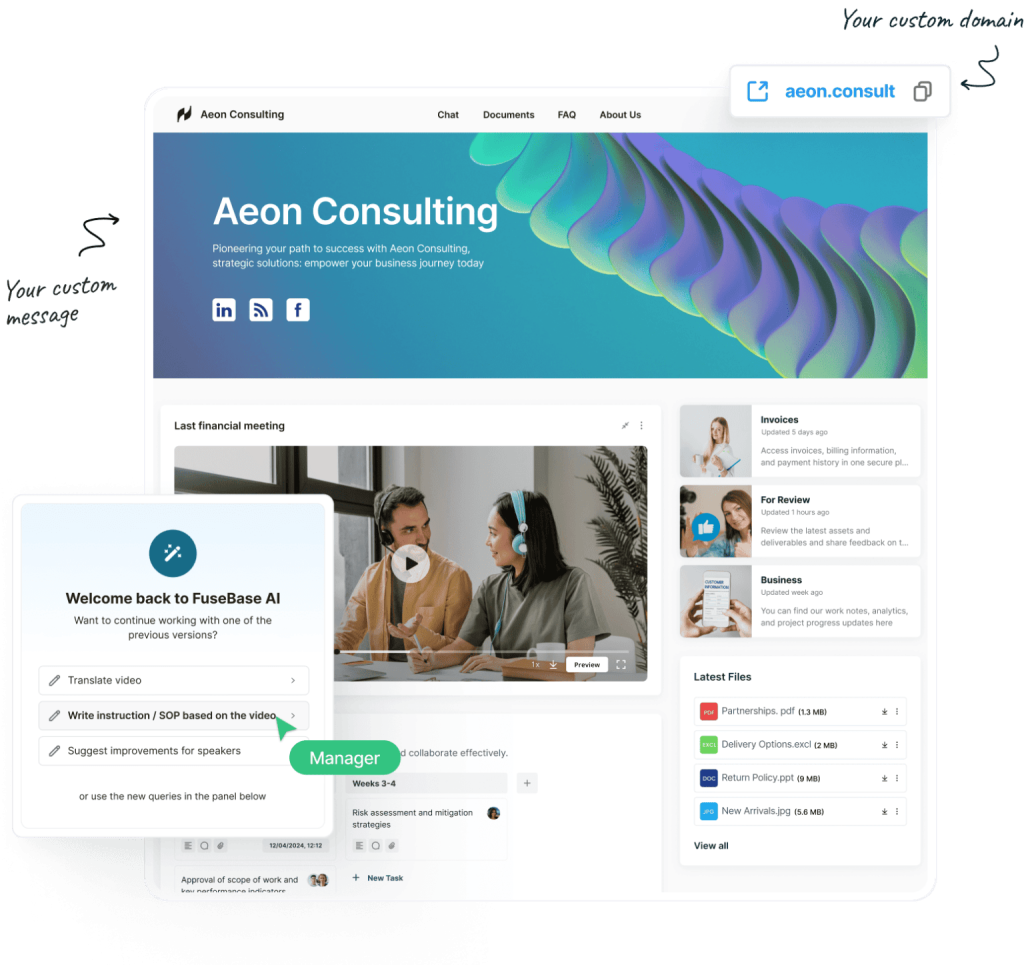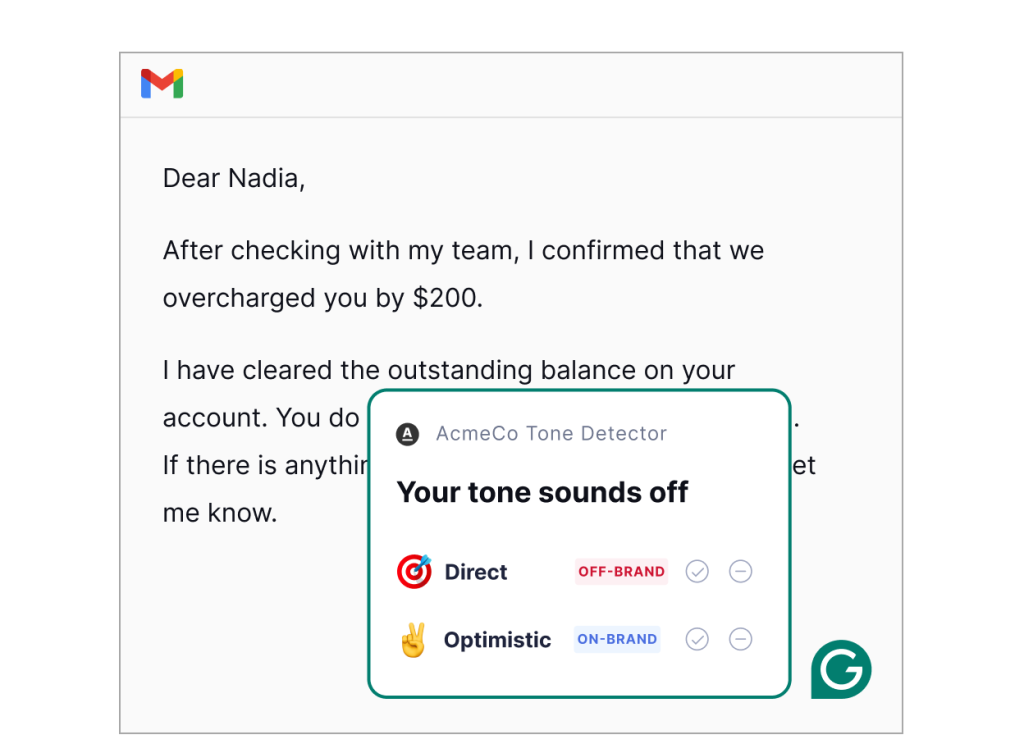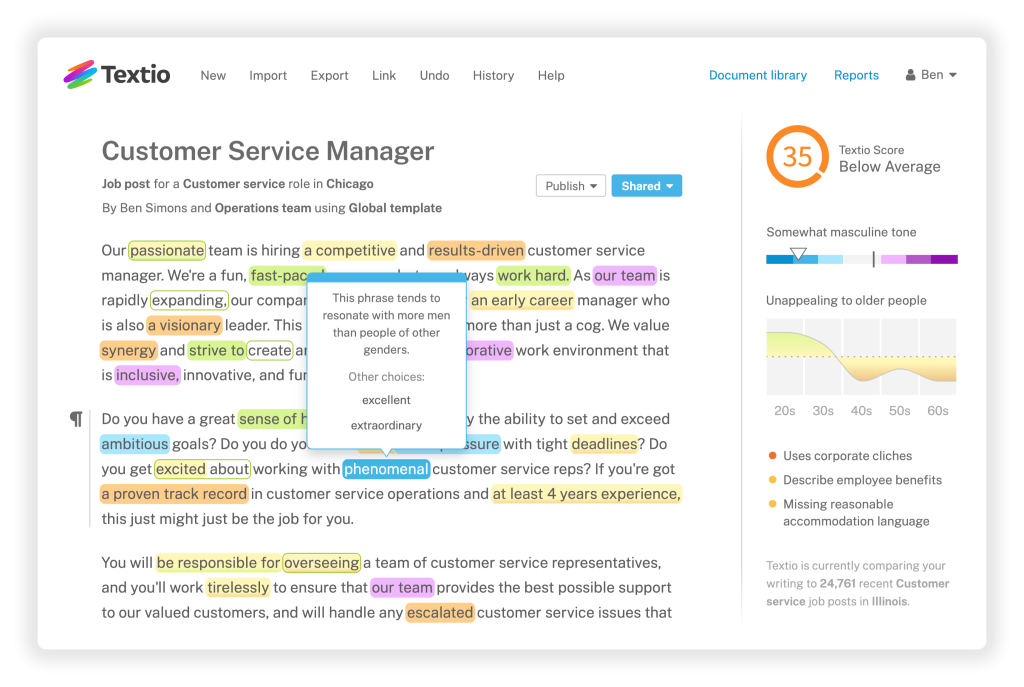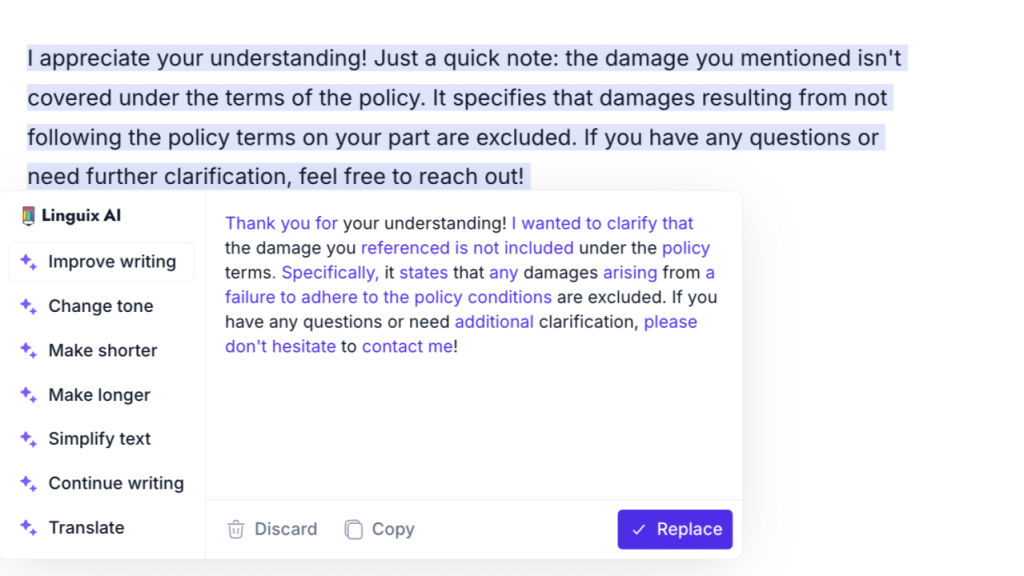
Your brand’s voice is more than just a writing style – it’s the personality your customers trust. However, as businesses scale, maintaining a unified voice across all touchpoints becomes increasingly difficult. That’s where AI tone checker software steps in. These tools use machine learning to analyze and adapt writing to match predefined tone and voice guidelines, ensuring your brand sounds consistent across emails, support tickets, ads, blogs, and more. Whether your tone is friendly, authoritative, or conversational, the right tool can help your team stay on-brand every time they hit “send” or “publish”.
TL;DR – Top AI Tone Checker Software
1. FuseBase – Complete platform for polished, brand-aligned communication
2. Sapling AI – Tone enhancement for customer support and sales teams
3. Grammarly Business – Everyday tone clarity for distributed teams
4. Writer.com– Enterprise-grade tone governance for brand voice control
5. Textio – Inclusive tone and bias detection for HR and internal messaging
6. Linguix Business – Tone refinement for multilingual and non-native English teams
What Is an AI Tone Checker and How Does It Safeguard Your Brand Voice?
Your brand voice is the emotional and stylistic fingerprint of your business. It’s what makes your messaging recognizable, trustworthy, and memorable – whether you’re speaking through a social post, a product page, or a support email. But maintaining a consistent tone at scale can be difficult, especially when content is being created across multiple departments, tools, and teams.
AI Tone Checkers are intelligent tools that analyze written content and provide real-time suggestions to ensure the tone of voice matches brand guidelines. They look at more than just word choice – they evaluate sentence structure, emotional cues, punctuation style, and intent. For brands with a clearly defined voice – and a need to scale without sacrificing quality – AI tone checker software acts as a safeguard. It helps every team member sound like the brand, even if they’re new, external, or operating independently.
Choosing the Right AI Tone Checker Software
Selecting the right AI tone checker isn’t just about checking tone – it’s about preserving the integrity of your brand’s voice across every word, sentence, and message. The ideal tool should act as a digital guardian of your tone, ensuring consistency whether you’re writing a tweet, a support reply, or a long-form article.
1. Look for Custom Tone Configuration
Your brand voice is unique. Choose software that allows you to define tone parameters – whether your voice is friendly and casual, authoritative and professional, or somewhere in between. The best tools let you create tone profiles, upload brand guidelines, and apply these across all content types and users.
2. Prioritize Enterprise-Ready Collaboration Features
If multiple people contribute to your brand’s messaging, your tone checker must support team workflows. Look for features like user roles, shared tone rules, team dashboards, and integrations with project management tools. This helps every writer – internal or external – stay in sync with your brand identity.
3. Ensure Real-Time Tone Feedback and Smart Suggestions
Real-time tone suggestions reduce friction in the writing process and give writers immediate guidance. AI software that flags misaligned tone as content is written helps your team catch issues early, before content goes live or reaches a customer’s inbox.
4. Evaluate Integration with Your Existing Tools
Your tone checker should integrate with the platforms your team already uses – Google Docs, Microsoft Word, email clients, CMS platforms, and chat tools. Smooth integration ensures widespread adoption and keeps tone feedback embedded into your content creation flow.
5. Check for Analytics and Reporting
To maintain brand consistency over time, you need visibility into how your team is performing. Choose software that provides tone usage insights, compliance reporting, and trends across content types or departments. These analytics can help identify gaps and guide tone evolution as your brand grows.
6. Balance Flexibility with Control
While tone checkers should guide your team, they shouldn’t restrict creativity. The best tools strike a balance between enforcing brand rules and offering flexibility for context-specific messaging. Make sure the tool enhances your tone, without making every message feel robotic.
Choosing the right AI tone checker software is a strategic decision. The right solution will do more than improve individual pieces of writing. It will unify your brand’s voice across departments, channels, and audiences. In a competitive market, that consistency becomes a powerful asset.
Top AI Tone Checker Tools in 2025
1. FuseBase (Your complete platform for polished, brand-aligned communication)

FuseBase is more than just an AI tone checker – it’s a fully integrated collaboration and communication hub designed for teams that manage client projects, internal workspaces, and external portals. At its core is the FuseBase AI Assistant, which analyzes the tone of your writing in real time, helping you align every message, document, and task update with your brand’s unique voice. Unlike standalone tone tools, FuseBase embeds tone analysis directly into your workflows, providing seamless guidance as you collaborate. It’s especially useful for distributed teams and agencies that need to maintain a cohesive voice across internal and external communications.
Key Features:
- Custom tone presets – Tailor tone settings for different teams, roles, or communication scenarios.
- Real-time tone analysis – Instantly detects tone mismatches and offers suggestions as you write.
- Context-aware feedback – Adjusts suggestions based on where and how you’re writing, whether it’s a client portal update or an internal project task.
- Seamless integration within FuseBase workflows – No need for additional tools or extensions.
- Supports multi-channel communication – Maintains tone consistency across client portals, project collaboration, and internal notes.
Limitations:
- May require some initial setup to define tone preferences for the best results.
🤖 Example of how AI Agents transform your work:
2. Sapling AI (Tone enhancement for customer support and sales teams)

Sapling AI is built for high-speed communication environments like customer support and sales. It integrates directly with CRM systems and messaging tools to offer tone suggestions in real time. Whether helping support agents respond more empathetically or ensuring sales reps maintain an upbeat tone, Sapling enhances communication without slowing down fast-paced workflows. It’s particularly effective for large customer-facing teams that need to maintain a professional, empathetic tone while handling high volumes of inquiries.
Key Features:
- Real-time tone suggestions – Ensures customer-facing messages remain clear, empathetic, and professional during fast-paced interactions.
- CRM integration – Works within Zendesk, Salesforce, Intercom, and other platforms, embedding tone coaching directly into the workflow.
- Performance tracking – Managers can monitor tone consistency across teams, ensuring brand voice alignment in customer interactions.
Limitations:
- Primarily designed for sales and support roles; not as robust for long-form content or general content creation.
- Limited tone customization beyond general emotional tone (empathy, clarity).
3. Grammarly Business (Everyday tone clarity for distributed teams)

Grammarly Business extends beyond grammar and spelling checks with a dedicated tone detection module, offering feedback on how messages might feel to recipients. It identifies whether your writing sounds confident, friendly, apologetic, or formal, and provides suggestions to align tone with your intent. Its user-friendly interface and quick setup make it ideal for distributed teams who need consistent tone across multiple platforms without deep customization.
Key Features:
- Tone detector – Flags tone indicators like “sounds confident,” “too blunt,” or “friendly” to ensure your message aligns with the intended emotional impact.
- Wide platform integration – Works across browsers, email platforms, Slack, and Google Workspace, making it ideal for teams communicating across different tools.
- Shared style and tone goals – Teams can align on tone preferences through shared guidelines, helping maintain consistency.
- Real-time feedback – Offers tone and clarity suggestions as you write, streamlining the editing process.
Limitations:
- Limited in brand-specific tone customization; operates with preset tone categories (confidence, formality, friendliness).
- Better suited for general tone clarity than for enforcing strict brand voice across complex organizations.
4. Writer.com (Enterprise-grade tone governance for brand voice control)

Writer.com is designed for large teams and enterprises requiring strict brand voice adherence across all content. It allows organizations to define detailed language rules, tone guidelines, and style preferences, enforcing them in real time as content is created. Writer integrates with tools like Google Docs, Microsoft Word, and various CMS platforms, ensuring that every piece of content aligns with brand standards. Its strength lies in its high level of customization, allowing tone rules to be as flexible or strict as needed.
Key Features:
- Custom tone and language rules – Allows businesses to create detailed tone profiles that reflect brand identity across different teams and departments.
- Real-time feedback across platforms – Works within Google Docs, CMS tools, Word, and Chrome, ensuring tone alignment wherever your team writes.
- Scalable for large teams – Provides admin controls for managing tone consistency across multiple writers and projects.
- Collaboration features – Supports shared glossaries and writing guidelines across departments.
Limitations:
- Requires upfront setup to define tone and style rules, which can be complex for smaller teams without established guidelines.
- Primarily focused on enterprise-level teams; may be too robust for small businesses or solo professionals.
🤖 Another example of AI that transforms how businesses work:
5. Textio (Inclusive tone and bias detection for HR and internal messaging)

Textio is a predictive tone and bias-checking tool designed to make workplace communication more inclusive and engaging. It’s widely used in HR, recruiting, and internal communication to ensure that job postings, company-wide announcements, and internal documents are written with clarity and inclusivity. Textio focuses on promoting equity and fairness in tone, helping companies avoid language that could unintentionally exclude or alienate certain groups.
Key Features:
- Bias detection – Flags language that may carry unintended bias or lack inclusivity, supporting equitable communication.
- Tone coaching – Guides writers toward language that fosters trust, engagement, and inclusivity.
- Analytics and reporting – Tracks tone usage and inclusivity trends across teams, helping leadership adjust communication strategies.
Limitations:
- Focuses heavily on inclusivity and internal HR use cases; less suited for broader content creation.
- Limited in handling broader emotional tone categories (e.g., confidence, assertiveness).
6. Linguix Business (Tone refinement for multilingual and non-native English teams)

Linguix Business offers tone adjustment alongside grammar and clarity support, with a focus on helping non-native English speakers refine tone for professional communication. It includes content templates and real-time feedback to ensure messages sound polite, confident, and aligned with business norms. Linguix is particularly helpful for global teams communicating across languages and cultural tone expectations.
Key Features:
- Tone adjustment suggestions – Helps writers refine tone for politeness, confidence, and formality.
- Content templates – Provides pre-built templates for different business scenarios (polite requests, formal proposals).
- Browser and app integrations – Supports major writing environments, including email and web-based platforms.
Limitations:
- Limited brand-specific tone alignment features; focuses more on general tone improvement.
- Tone detection isn’t as advanced as enterprise-focused tools.
Wrap-up
Maintaining a consistent brand voice across every piece of content is essential for building trust, engagement, and professionalism. AI tone checker software makes this easier by providing real-time feedback to ensure your messaging aligns with your brand’s unique personality, whether you’re writing emails, reports, client updates, or internal communications. From enterprise-grade solutions like Writer.com to tools designed for inclusivity like Textio, there’s no shortage of options.
But when it comes to a fully integrated, context-aware tone solution that works seamlessly across your entire communication workflow, FuseBase leads the way. With its built-in AI Assistant, FuseBase doesn’t just check your tone – it helps shape every message to reflect your brand’s voice, no matter the platform or context. For teams and professionals who want more than just tone correction, FuseBase delivers a complete solution for confident, brand-aligned communication.

